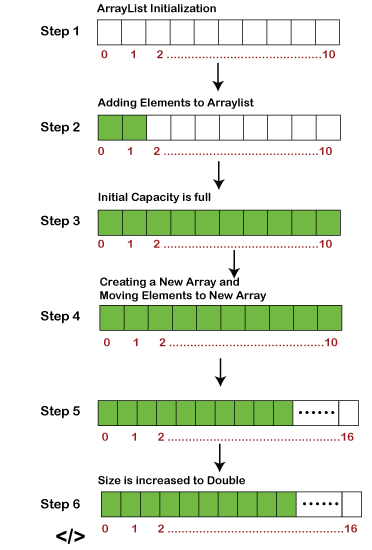ArrayList Implementation in JavaArrayList is a class of Java Collection framework. It uses a dynamic array for storing the objects. It is much similar to Array, but there is no size limit in it. We can add or remove the elements whenever we want. We can store the duplicate element using the ArrayList; It manages the order of insertion internally. The ArrayList class is much more flexible than the traditional Array. It implements the List interface to use all the methods of List Interface. It takes place in java.util package. The ArrayList class inherits the AbstractList class and implements the List Interface. The elements of it can be randomly accessed. It can not be used for primitive types such as int, char, etc.; for these data types, we need a wrapper class. The difference between Array and ArrayList is that Arraylist provides a dynamic array that can be expanded when needed. In Array, we have to specify the size of the Array during initialization, but it is not necessary for ArrayList. By default, it takes its size to 10. ArrayList class can be declared as follows: ArrayList can be defined as follows: Consider the below example: Output: List objects are: [Sam, Sandy, Joe, Arya, Nik] After Removing Nik, List Objects are[Sam, Sandy, Joe, Arya] From the above example, we can see how we can add or remove the List's objects. Let's understand how it works internally: 
How ArrayList Works InternallyWhen we initialize an ArrayList using the below syntax: It creates an Array with the default capacity, which is 10. It invokes the default constructor of the ArrayList class. It uses an empty array instance to create the new object, and the following code is executed by the Java compiler: in Java 7 or previous version: in Java 8 or later version: From the above code, we can see an empty ArrayList is internally created with the default capacity, which is 10. when we add the first element in it, it will be expanded to DEFAULT_CAPACITY. ArrayList uses an Object [] Array to add, remove, and traverse the element. for the prior versions of Java than Java 8, it specifies the objects as follows: As we can see from the above line of code, from Java 8, the private keyword has been removed for providing access to nested classes such as Itr, ListItr, SubList. We can also define the List with the specific capacity. When we provide an initial capacity, the ArrayList constructor is invoked internally to specify the Array internally. For example, if we define an array list with the capacity of 20, we have to define the ArrayList as follows: Then the following code will be executed by the Java compiler: In Java 7 or previous versions: From the above code, we can see the array size will be equal to the specified Array. In Java 8 or later versions: From the above code, we can see the array size will be equal to the specified Array. We can also create an object of ArrayList for a specific collection by executing the below line of code: The above code will create a non-empty list having the objects of LinkedList. How the ArrayList Grows DynamicallyWhen we add a new object to the ArrayList, it will check for the initial size of the ArrayList whether it has space or not. If there is enough space for the new object, it will add simply using the add() method. If there is not enough space to add a new object, it will dynamically increase the size of the Array by that much capacity. Consider the below implementation of add method (In Java 7 or later): from the above code,
Performance of ArrayListIn the ArrayList, the add operation requires o(n) time; other operations are run in linear time. The size, isEmpty, get, set, iterator, and listIterator tasks run in a constant time of O(1). Summary
|
 For Videos Join Our Youtube Channel: Join Now
For Videos Join Our Youtube Channel: Join Now
Feedback
- Send your Feedback to [email protected]
Help Others, Please Share










